All the solutions provided in McGraw Hill My Math Grade 3 Answer Key PDF Chapter 11 Lesson 1 Estimate and Measure Capacity will give you a clear idea of the concepts.
McGraw-Hill My Math Grade 3 Answer Key Chapter 11 Lesson 1 Estimate and Measure Capacity
The amount of liquid a container can hold is called its capacity. Capacity is also known as liquid volume.
One unit is one specific amount of measurement.
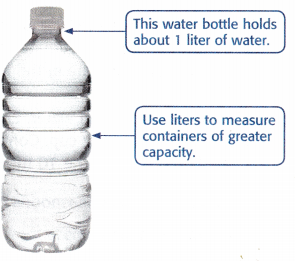
A metric unit is a unit of measure in the metric system. One metric unit of capacity is a liter (L).
Measure It
How much liquid is a liter?
1. Find three containers. Estimate whether each holds less than, about, or more than 1 liter. Write the name of the container. Mark your estimate. An example is shown.

2. Pour liquid from the container into the 1-liter measuring cup to check each estimate. Record your results in the table.
Answer:
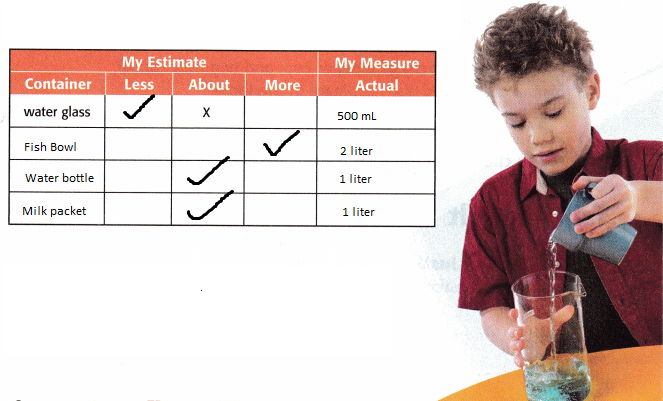
To measure the liquid capacity of smaller containers, you need a smaller unit of measure.
A smaller metric unit of capacity is a milliliter (mL).
A dropper holds about 1 milliliter of liquid.
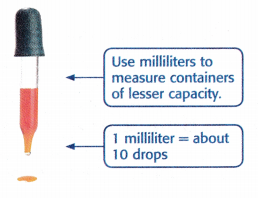
Try It
How much liquid is a milliliter?
1. About how many milliliters do you think a teaspoon holds? Estimate its capacity. Record your estimate in the table.
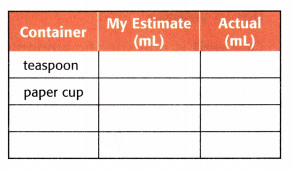
Answer:

2. Fill a teaspoon with water. Empty it into a metric measuring cup. Continue until the liquid is up to the 10 mL marking.

About how many teaspoons did you use? about _____________ teaspoons
Together, about _____________ teaspoons have the capacity of 10 mL. What is the capacity of 1 teaspoon then? _____________
Answer:
100/10 = 10
Together, about 10 teaspoons have the capacity of 10 mL.
The capacity of 1 teaspoon is 10 mL.
3. Estimate the capacity of a paper cup, and two other small containers. Record each estimate in the table.
Answer:
The capacity for a paper cup is 100 mL.
2 × 100 = 200 mL
4. Pour liquid from each small container into the measuring cup to check each estimate. Record your results in the table.
Answer:

Talk About It
Question 1.
Mathematical PRACTICE Justify Conclusions How did you determine an estimate for the paper cup?
Answer: The estimated capacity for the paper cup is 100 milliliters.
Practice It
Circle the better unit to measure each capacity.
Question 2.
pot of soup
milliliter
liter
Answer:
The better unit to measure the capacity of a pot of soup is milliliter.
Question 3.
juice box
milliliter
liter
Answer: The better unit to measure the capacity of a juice box is a liter.
Question 4.
wading pool
milliliter
liter
Answer: The better unit to measure the capacity of the wading pool is liter.
Question 5.
bottle of glue
milliliter
liter
Answer: The better unit to measure the capacity of the bottle of glue is a milliliter.
Question 6.
pitcher of lemonade
milliliter
liter
Answer: The better unit to measure the capacity of pitchers of lemonade is milliliter.
Question 7.
fish aquarium
milliliter
liter
Answer: The better unit to measure the capacity of the fish aquarium is liter.
Circle the better estimate.
Question 8.
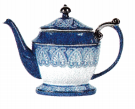
400 mL
400 L
Answer: The capacity is 400 mL.
Question 9.

4 mL
40 L
Answer: The capacity is 40 L.
Question 10.
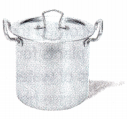
10 mL
10 L
Answer: The capacity is 10 L.
Question 11.

900 mL
900 L
Answer: The capacity of the milk is 900 mL.
Question 12.
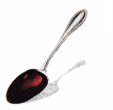
2 mL
2 L
Answer: The capacity is 2 mL.
Question 13.
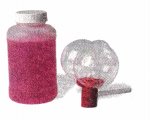
100 mL
100 L
Answer: The capacity is 100 mL
How much water is in each container? Circle the amount.
Question 14.
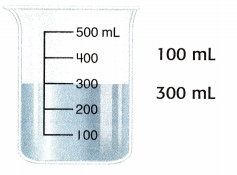
Answer:

From the above figure, we can see that the container has 300 mL of water.
Question 15.
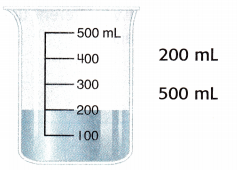
Answer:

From the above figure, we can see that the container has 200 mL of water.
Apply It
Question 16.
Riley bought 2 juice boxes. The capacity of one juice box is shown. What is the total capacity of 2 juice boxes?

Answer:
Given,
Riley bought 2 juice boxes
2 × 50 ml = 100 mL
Thus the total capacity of 2 juice boxes is 100 mL.
Question 17.
Mathematical PRACTICE Be Precise Avery’s recipe asks for 100 mL of milk. She only has a 10 ml measuring cup. How many times will she need to fill her measuring cup to get the right amount of milk for her recipe? Explain.
Answer:
Given,
Avery’s recipe asks for 100 mL of milk.
She only has a 10 ml measuring cup.
100 ÷ 10 = 10
Thus 10 times she needs to fill her measuring cup to get the right amount of milk for her recipe.
Question 18.
Anna recorded the amount of water she gave her tomato plants for the past 5 days. The table shows the amounts of water Anna recorded. How much water did Anna give her tomato plants the last 5 days?

Answer:
Given,
Anna recorded the amount of water she gave her tomato plants for the past 5 days.
14 + 12 + 4 + 26 + 10 = 66 mL
Thus Anna give her tomato plants 66 mL of water for the past 5 days.
Question 19.
Mathematical PRACTICE Model Math Name 3 items sold in a grocery store that are packaged in liter containers.
Answer: The 3 items sold in a grocery store that are packaged in liter containers are milk, oil and juice.
Write About It
Question 20.
Why are there two different units of measure for measuring capacity?
Answer:
There are two different units of measure for measuring capacity because capacity is mass and also the amount of liquid.
McGraw Hill My Math Grade 3 Chapter 11 Lesson 1 My Homework Answer Key
Practice
Circle the better unit to measure each capacity.
Question 1.

milliliter
liter
Answer:
The better unit to measure the capacity of the nail polish is a milliliter.
Question 2.

milliliter
liter
Answer: The better unit to measure the capacity of the drum is the liter.
Question 3.

milliliter
liter
Answer:
The better unit to measure the capacity of the tin is the liter.
Question 4.

milliliter
liter
Answer:
The better unit to measure the capacity of the cup is milliliter.
How much water is in each container? Circle the amount.
Question 5.
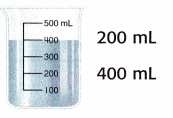
Answer:

The water in the container is 400 mL.
Question 6.
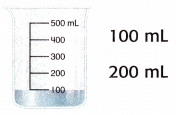
Answer:

The water in the container is 100 mL.
Problem Solving
Question 7.
Mathematical PRACTICE Use Mental Math Ian is going to water his plants. Is it reasonable to say he will fill the watering can with 3 liters of water? Explain.
Answer:
Yes
3 Liters is a reasonable amount for a watering can to hold.
Question 8.
Gianna is heating a can of soup for lunch. Is it reasonable to say she is heating 3 milliliters or 300 milliliters of soup? Explain.
Answer:
It is reasonable to say she is heating 300 milliliters because 3 milliliters is only about one spoonful.
Question 9.
Vincent is painting all four walls of his bedroom. Is it more reasonable to measure the paint he will use in milliliters or liters? Explain.
Answer:
Given,
Vincent is painting all four walls of his bedroom.
It will probably take a lot of paint to cover four walls. So, it is more reasonable to measure the paint he will need in liters.
Vocabulary Check
Match each vocabulary word or set of words to its meaning.
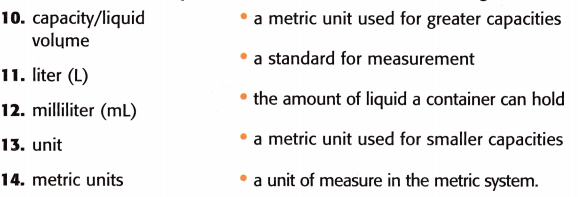
Answer:
